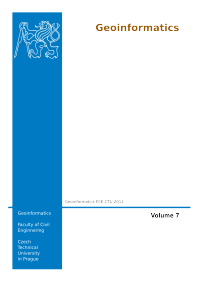GvSIG in the academic education of heterogeneous target groups – experiences in lectures, exercises and eLearning
DOI:
https://doi.org/10.14311/gi.7.1Keywords:
gvSIG, eLearning, online-teaching, blended learningAbstract
Thanks to easier operability and a growing range of functions, open source products are increasingly being used in teaching GIS to students of various course programs. The elaboration of such courses poses the challenge of taking into account different study paths, allowing for student autonomy (e-learning), and choosing the right software. The article suggests answers to these questions by presenting the classes offered at the University of Applied Sciences in Deggendorf and the University of Passau since winter 2010/11 as well as ideas for future course offers.References
Bähr, H. P. (2005), eLearning – The Possible and Impossible. – Web: http://www.ifp.unistuttgart.de/publications/phowo05/370baehr.pdf (06.04.2011).
Engemaier, R. & Schernthanner, H. (2009): Freie Geoinformationssoftware in der universitären Ausbildung – Status und Potenziale. In: Jeckel, Th., Koller, A. & Donert, K. (Hrsg.): Lernen mit Geoinformationen IV. – Heidelberg, S. 230-234.
Littlejohn, A. & Pegler, C. (2007), Preparing for Blended E-Learning. – London.
Kanwischer, D. (2004): Selbstgesteuertes Lernen, E-Learning und Geographiedidaktik. Grundlagen, Lehrerrolle und Praxis im empirischen Vergleich. – Berlin.
Kannwischer, D., Reudenbach, CH. & Schulze, U. (2009): Wie kommt der Transrapid nach Marburg? – GIS und problembasiertes Lernen in der Hochschule. In: Jeckel, #Th., Koller, A. & Donert, K. (Hrsg.): Lernen mit Geoinformationen IV. – Heidelberg, S. 200-219.
Kerres, M. (2002), Online- und Präsenzelemente in hybriden Lernarrangements kombinieren. In: Hohenstein, A. & Wilbers, K. (Hrsg), Handbuch E-Learning. – Köln.– München / Wien. Kap. 4.5, S. 1-19
Sauter, A. M., Sauter, W. & Bender, H. (2004), Blended Learning, effiziente Integration von E-Learning und Präsenztraining. – Darmstadt.
Scheffer, J. & Zink, R. (2010): Neue Seminarformen als Chance für die Geographie – Zukünftige Positionierungsmöglichkeiten des Faches am Beispiel eines GIS-Projektes. – Geographie und Schule 32, Heft 187, S. 36-39.
Schleicher, Y. (2004): Internet und e-Learning. Was motiviert Schülerinnen und Schüler? Empirische Forschungsergebnisse und praktische Beispiele zur Umsetzung – Geographie und Schule 26, Heft 147, S. 16-22.
Siegmund, A. & Naumann, S. (2009): GIS in der Schule. Potenziale für den Geographieunterricht von heute. – Praxis Geographie 2, S. 4-8.
Weber, P.J. & Werner, S. (2005), Online Lernen in der Aus- und Weiterbildung. Ein Modell für die Praxis. – Hamburg.
Zink, R., Schriever, J. & Marquardt, A. (2010): Schule, Moodle und GIS: Chancen nutzen! Aufbau eines Kursraumes für Blended Learning mit GIS. In: Jekel, Th., Koller, A., Donert, K. & Vogler, R. (Hrsg), Learning with Geoinformation V – Lernen mit Geoinformation V. – Heidelberg. S. 118-127.
Downloads
Published
Issue
Section
License
- Authors retain copyright and grant the journal right of first publication with the work simultaneously licensed under a Creative Commons Attribution License that allows others to share the work with an acknowledgement of the work's authorship and initial publication in this journal.
- Authors are able to enter into separate, additional contractual arrangements for the non-exclusive distribution of the journal's published version of the work (e.g., post it to an institutional repository or publish it in a book), with an acknowledgement of its initial publication in this journal.
- Authors are permitted and encouraged to post their work online (e.g., in institutional repositories or on their website) prior to and during the submission process, as it can lead to productive exchanges, as well as earlier and greater citation of published work (See The Effect of Open Access).

